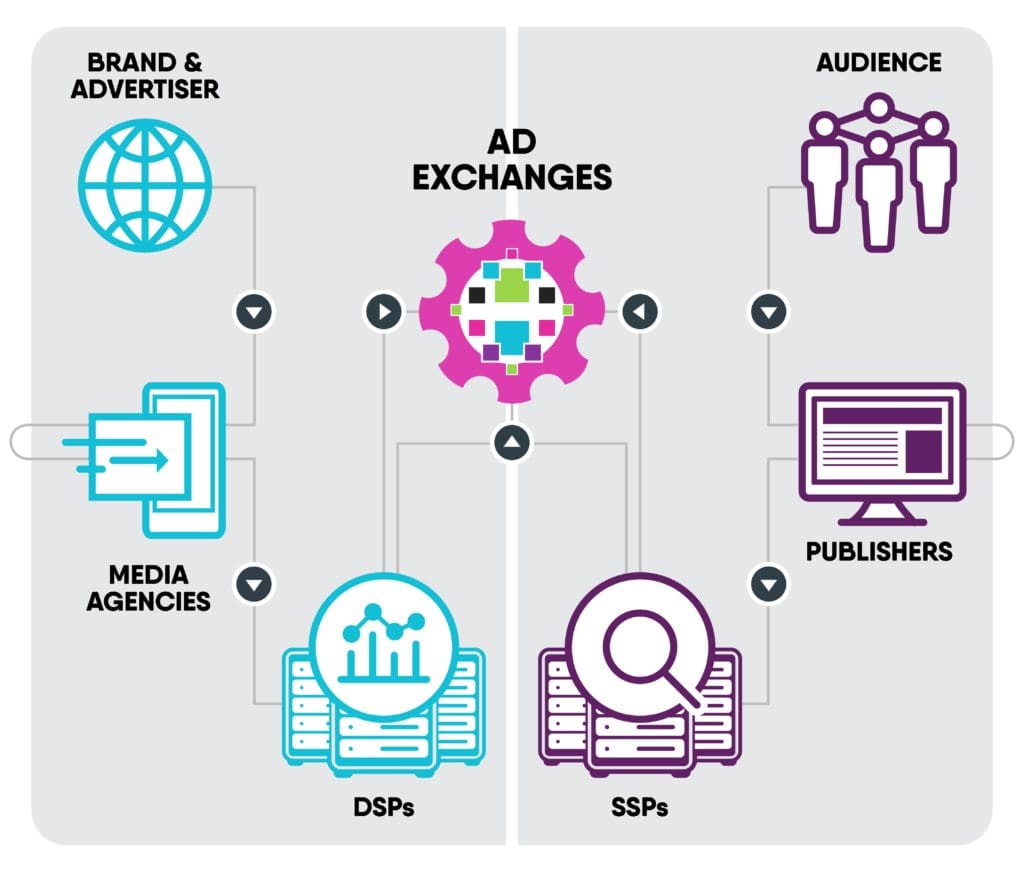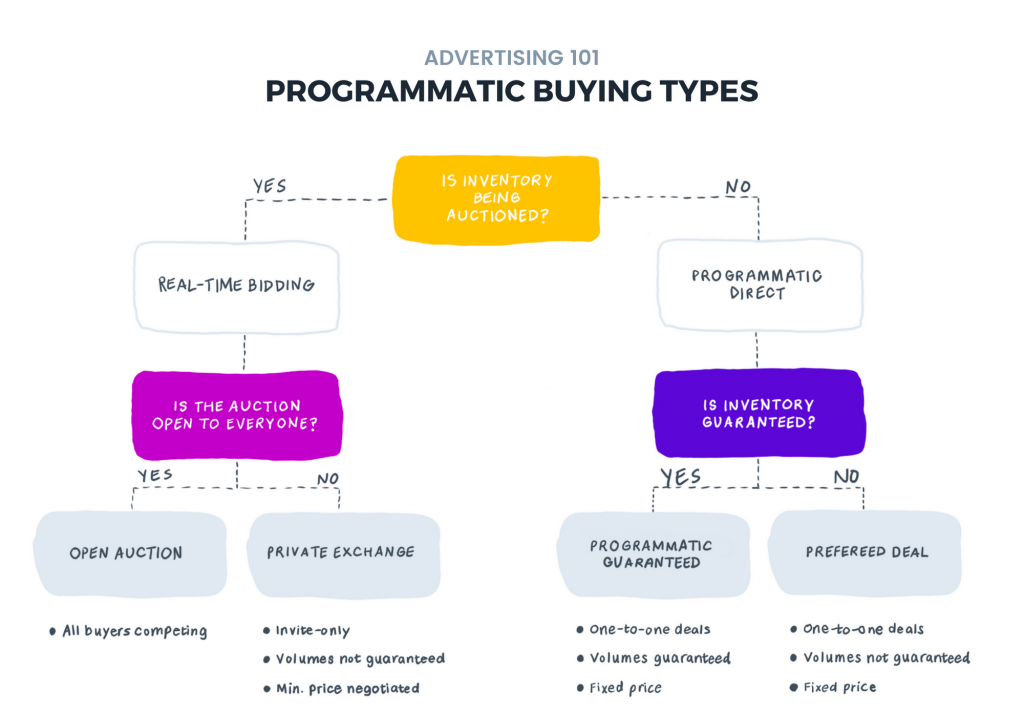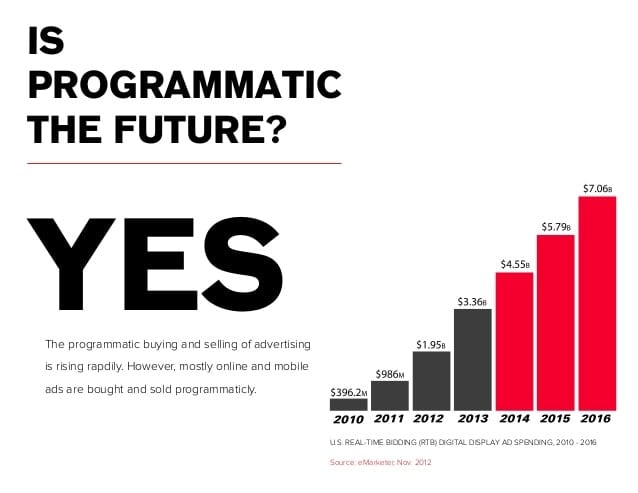The Definitive Guide to Programmatic Ads
In digital marketing, “programmatic” refers to the use of software to automate the buying and selling of advertising. Programmatic ads are becoming more sophisticated daily as marketers demand more control over where their ads appear and how much they will pay.
And for advertisers, programmatic media offers many advantages over traditional, manual ad space buying. Perhaps most importantly, it allows marketers to target their ads more precisely to the audiences they want to reach.
Table of Contents
What Is Programmatic Media?
Programmatic media is a form of advertising using computer algorithms to purchase ad space in real time. This differs from traditional methods, such as print or television ads, where space is bought in advance.
The advantage of programmatic buying is that it allows for more targeted and efficient use of advertising resources. For example, marketers can target specific demographics, locations, and individual consumers.
Programmatic buying can help to optimise ad campaigns on the fly based on real-time data. Because of this, programmatic media has become an increasingly popular choice for advertisers looking to get the most out of their budget.
How Do Programmatic Ads Work?

The programmatic ecosystem includes several players, each with its own role.
The four critical components of programmatic media are:
- Ad exchanges
- Supply-side platforms (SSPs)
- Demand-side platforms (DSPs)
- Data management platforms (DMPs)
Ad Exchanges
An ad exchange is an online marketplace where publishers and advertisers can buy and sell ad space in real time. Ad exchanges provide a central place for buyers and sellers to connect, making transacting easier and faster.
Advertisers can use ad exchanges to reach their target audiences more effectively, and publishers can use them to monetise their websites and increase revenue.
These exchanges match ads with websites, with readers likely interested in the advertised products or services. They also allow advertisers to bid on ad space, ensuring that their ads are seen by the most likely to convert.
Because of their high-quality targeting and impressive results, ad exchanges offer a win-win solution for advertisers and publishers.
Supply-Side Platforms
A supply-side platform (SSP) is an AdTech platform that helps publishers sell their advertising inventory to buyers in an automated fashion. SSPs are designed to streamline the process of selling ad space and to help publishers optimise their revenue.
Typically, a publisher will integrate with an SSP to gain access to its demand-side platform (DSP) partners. This way, the publisher can reach a larger pool of potential advertisers and sell more ad inventory.
SSPs have become increasingly popular in recent years as publishers seek ways to boost their revenue. However, some criticism has been levelled at SSPs for driving up the cost of advertising and eating into publisher margins.
Demand-Side Platforms
A demand-side platform (DSP) software system allows advertisers to buy ad inventory from publishers through real-time bidding (RTB). Advertisers use DSPs to purchase display, video, and mobile advertising inventory from ad exchanges and publishers.
The difference between supply-side and demand-side platforms is that SSPs help publishers sell their ad inventory, while DSPs help advertisers buy it.
DSPs give advertisers the ability to target specific audiences with laser precision. They also allow advertisers to track, measure, and optimise their campaigns.
In other words, DSPs and SSPs are two sides of the same coin. One helps publishers sell their ad space, while the other helps advertisers buy it.
Data Management Platforms
A data management platform (DMP) collects and organises data from various sources into a single database. This data can be used to create detailed profiles of individual consumers.
DMPs are often used with demand-side platforms (DSPs) to help advertisers target their ad campaigns. By combining the data from a DMP with the targeting capabilities of a DSP, advertisers can create highly personalised ad campaigns that are more likely to convert.
DMPs are also used by publishers to understand their audiences better and to sell more targeted advertising.
The 3 Types of Programmatic Buying

When an ad agency like Revelation Digital buys programmatic media on behalf of its clients, it use one of three methods:
- Programmatic direct
- Real-time bidding (RTB)
- Private marketplaces (PMP)
1 – Programmatic Direct
Programmatic direct is the simplest form of programmatic buying. In this method, the advertiser buys ad space directly from the publisher without going through an intermediary.
Programmatic direct deals are typically done on a CPM basis and usually involve fixed prices and guaranteed placement.
The main advantage of programmatic direct is that it gives advertisers more control over where their ads will be seen. The downside is that programmatic direct deals can be more expensive than other types of programmatic buying, and they often involve long-term contracts.
2 – Real-Time Bidding (RTB)
Real-time bidding (RTB) is the most common form of programmatic buying. In RTB, advertisers compete against each other in a real-time auction to win ad space.
Advertisers set their bid price and targeting criteria in advance, and then they are matched with publishers with ad inventory that meets their criteria.
The auction takes place in real time, and the advertiser that wins the auction gets their ad placed on the publisher's site.
RTB is an excellent way for advertisers to get their ads in front of their target audience at a lower cost. The downside is that RTB can be very competitive and challenging to win the auction.
3 – Private Marketplaces (PMPs)
A private marketplace (PMP) is a type of programmatic buying that allows advertisers to buy ad space directly from publishers without going through an intermediary.
In a PMP, the publisher sets the price and terms of the deal and then invites a select group of advertisers to participate.
PMPs are similar to direct programmatic deals but usually involve more flexible terms. The caveat is that not all publishers offer PMPs, and the ones usually only offer them to select advertisers.
Premium publishers like The New York Times and The Wall Street Journal use these deals because they want more control over who buys their ad space and at what price.
Which Programmatic Buying Method is Right for You?
The type of programmatic buying that is right for you will depend on your advertising goals and budget.
Here are a few considerations to keep in mind:
- If you're someone who doesn't need a lot of hand-holding, programmatic direct might be a suitable option.
- If you're on a tight budget, RTB is an excellent way to get your ads in front of your target audience without breaking the bank.
- And if you're looking for more control over where your ad appears, you'll want to look on private marketplaces for the most favourable ad solutions.
No matter which type of programmatic buying you choose, the important thing is to work with an experienced agency that can help you navigate the complexities of the programmatic landscape.
3 Benefits of Programmatic Advertising

Programmatic media is an emerging marketing strategy quickly gaining popularity among marketers and advertisers who want to make the most efficient use of their advertising budgets.
Let's take a look at three key benefits:
1 – Programmatic media buying is highly efficient.
Efficiency is one of the essential benefits of programmatic advertising. Using data and technology, programmatic buying allows marketers to target their ideal audience precisely.
This means you can use your budget more efficiently by only targeting people likely to be interested in your product or service.
Programmatic media buying is also much faster than traditional methods of media buying.
In the past, media buyers would have to negotiate with individual publishers to secure ad space. With programmatic buying, all of this can be done automatically in real time.
This means you can get your ads in front of your target audience faster.
2 – Instantaneous measurement and adjustments.
Since the buying process happens in real time, programmatic advertising allows you to measure the performance of your campaigns right away and make adjustments accordingly. With programmatic media buying, you can see how your ad performs almost immediately and make changes on the fly to improve results. This instant feedback loop allows you to fine-tune your campaigns for maximum efficiency and ROI.
In addition, programmatic ads also provide granular data that you can use to improve future campaigns. You can track click-through rates, conversion rates, and even the specific demographics of the people interacting with your ads.
3 – Marketers can use a variety of channels.
With programmatic media, you can reach your audience at multiple touchpoints, maximising the potential for building your brand.
A few ways you can reach your end users include:
- Display: Programmatic display advertising allows you to serve banner ads on websites and apps your target audience is visiting.
- Video: You can use programmatic advertising to reach your audience through online videos, including pre-, mid-, and post-roll ads.
- Mobile: Mobile ads reach their target audience through their smartphones and tablets.
- Social: Social media platforms like Facebook, Instagram, and Twitter all offer programmatic advertising solutions that allow you to place your ads directly in front of your target audience.
- CTV: Connected TV (CTV) devices like Roku, Amazon Fire TV, and Apple TV offer programmatic advertising solutions that place your video ads directly in front of cord-cutters and other television viewers.
Endnote
Programmatic ads are a complex and ever-evolving landscape. To succeed, you'll need to partner with an experienced agency to help you navigate the complexities of programmatic media buying. But programmatic advertising is worth considering if you're looking for a more efficient and effective way to reach your target audience.
By following the tips in this guide, you can set your business up for success with this innovative form of advertising.
